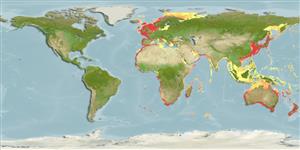Teleostei (teleosts) >
Zeiformes (Dories) >
Zeidae (Dories)
Etymology: Zeus: Derived from Greek Theos, Zeys = the supreme Greek god (Ref. 45335).
More on author: Linnaeus.
Environment: milieu / climate zone / depth range / distribution range
Ecology
Marine; brackish; benthopelagic; oceanodromous (Ref. 35388); depth range 5 - 400 m (Ref. 9563), usually 50 - 150 m (Ref. 4968). Temperate; 75°N - 49°S, 17°W - 177°E (Ref. 54935)
Worldwide in distribution. Eastern Atlantic: Norway to South Africa, also the Mediterranean and Black Sea. Western Pacific: Japan, Korea, Australia and New Zealand. Also known from the Indian Ocean.
Length at first maturity / Size / Weight / Age
Maturity: Lm 35.1, range 29 - 35 cm
Max length : 90.0 cm TL male/unsexed; (Ref. 6953); common length : 40.0 cm TL male/unsexed; (Ref. 6953); max. published weight: 8.0 kg (Ref. 35388); max. reported age: 12 years (Ref. 5377)
Found in areas close to the sea bed (Ref. 6390). Generally solitary. Feeds mainly on schooling bony fishes, occasionally on cephalopods and crustaceans (Ref. 27121). Reproduction takes place at the end of winter and at the start of spring in the northeastern Atlantic, earlier in the Mediterranean. Eggs are pelagic, maturity reached at 4 years (Ref. 36731). Sold fresh (Ref. 9563) and frozen (Ref. 9988). Can be steamed, fried, broiled, boiled, microwaved and baked (Ref. 9988). The flesh is excellent but is utilized little in West Africa (Ref. 5377).
No studies of their reproductive development or early life history have been undertaken in Australia (Ref. 6390). Pelagic eggs (Ref. 35388).
Karrer, C. and A. Post, 1990. Zeidae. p. 631-633. In J.C. Quero, J.C. Hureau, C. Karrer, A. Post and L. Saldanha (eds.) Check-list of the fishes of the eastern tropical Atlantic (CLOFETA). JNICT, Lisbon; SEI, Paris; and UNESCO, Paris. Vol. 2. (Ref. 6953)
IUCN Red List Status (Ref. 130435)
Threat to humans
Harmless
Human uses
Fisheries: commercial; gamefish: yes; aquarium: public aquariums
Tools
Special reports
Download XML
Internet sources
Estimates based on models
Preferred temperature (Ref.
123201): 6.7 - 23.7, mean 13.6 °C (based on 1223 cells).
Phylogenetic diversity index (Ref.
82804): PD
50 = 0.7656 [Uniqueness, from 0.5 = low to 2.0 = high].
Bayesian length-weight: a=0.01660 (0.01364 - 0.02020), b=2.91 (2.85 - 2.97), in cm total length, based on LWR estimates for this species (Ref.
93245).
Trophic level (Ref.
69278): 4.5 ±0.8 se; based on diet studies.
Resilience (Ref.
120179): Medium, minimum population doubling time 1.4 - 4.4 years (K=0.15; tm=3-4; tmax=12).
Prior r = 0.63, 95% CL = 0.41 - 0.94, Based on 2 stock assessments.
Fishing Vulnerability (Ref.
59153): High vulnerability (59 of 100).
Climate Vulnerability (Ref.
125649): Moderate vulnerability (38 of 100).
Nutrients (Ref.
124155): Calcium = 14.1 [8.1, 27.2] mg/100g; Iron = 0.246 [0.139, 0.432] mg/100g; Protein = 19.2 [16.0, 21.6] %; Omega3 = 0.65 [0.34, 1.23] g/100g; Selenium = 21 [10, 42] μg/100g; VitaminA = 16.8 [4.4, 66.5] μg/100g; Zinc = 0.368 [0.254, 0.546] mg/100g (wet weight); based on
nutrient studies.
